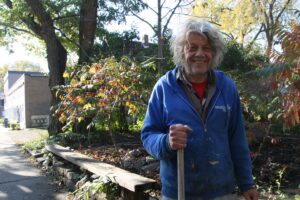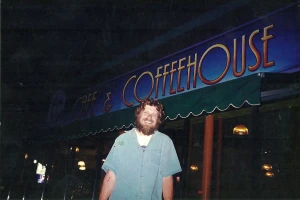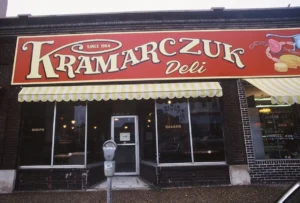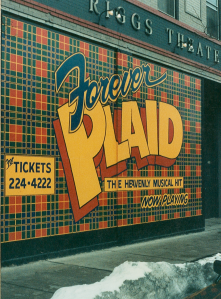BY STEPHANIE FOX

Phil Vandervaart
You may not know Phil Vandervaart personally, but you know his work. He has been a Twin Cities professional sign painter since 1983, creating artistic and imaginative signage for hundreds of small businesses in Minneapolis since moving here from Chicago. Some of his works include Palmer’s Bar, Kramarczuk’s, May Day Cafe, the Lava Lounge and the Brave New Workshop.
His connection to so many small storefront businesses is why he sees the city’s new policy to eliminate street parking to the advantage of bike traffic as a threat to the survival of many of those businesses.
Vandervaart lives in a single-family home on Minnehaha Avenue, a street lined with homes, apartment houses and a many small businesses. When the city first proposed putting bike lanes along the street, it threatened to take down a number of boulevard shade trees. Neighbors protested and bike lanes were installed but the trees and street parking remained, he said. That was the beginning of his crusade.
For nearly 40 years in Minneapolis, Vandervaart said, to operate a street-front business you had to prove that there was adequate parking in the area. Some businesses had small parking lots, but many relied on nearby street parking. With those parking spots gone, many of these businesses are hurting.
On Lake Street, the parking ban caused workers at Two Bettys Green Cleaning Service’s refill station, where cleaners pick up supplies, to park more than a block away and haul the equipment to their cars. The business’s founder, Anna Tsantir, had 80 cleaners a day come to that location, and they had nowhere to park. The city had eliminated a half-dozen critical parking spots in front of the business.
“At 46th and Cedar, they eliminated 40 spots. A woman with an antique business there can’t even allow people to park there to unload,” Vandervaart said.
“My whole life has been brick-and-mortar storefronts. It’s what I work on. I hear from people, many wanting to open a small business,” he said. And, he says, for small shops it’s getting more difficult. In addition to eliminating parking, many older buildings are being torn down, replaced by mixed-use apartment buildings with apartments above and large commercial spaces on the street front.
“I study these older buildings. They don’t make them like this anymore. They are quirky spots that offer opportunities for really small establishments. The new ones they’re building are all empty. Go look at them. They are all empty. They eliminated spots for small businesses. Even if they would rent them to smaller businesses, they’d be too expensive. It’s a write-off for them,” said Vandervaart.
The history of Minneapolis neighborhoods began 140 years ago when the city was expanding. The original street layout was designed for horses and carriages. “But in the 1920s, as motor vehicles began to replace horses, the 10-foot-wide horse alleys became places for restaurants like Al’s Diner,” Vandervaart said. “Now, with older buildings and parking disappearing, places with rents at a thousand a month will also disappear, replaced by rents five times that amount.”
Vandervaart blames Mayor Frey and out-of-town investors. “It’s a scam,” he said. “They don’t care about our city’s lifestyle. It’s a money thing. And Frey is a developer in chief.” (The mayor’s office did not reply to questions about this issue.)
“There will be no other places like these after these are gone. They are selling our souls and fortunes to the investor class. All of Minneapolis will look like Stadium Village, which is no longer a village, just corporate housing,” said Vandervaart.
He has concerns about other issues he sees as connected to the parking elimination situation.
Walkability? “It is already a walkable town. Minneapolis was first laid out in the 1880s and all these buildings were built in the span of a decade. This is a product of the natural evolution of our town.”
And the push to create density? “A single-family home is the only way for most people to build wealth,” he said. “We don’t need more apartment houses. They’re sucking away equity.”
But Vandervaart offers some solutions to these problems. “Don’t put the bike trails on main roads. We don’t need to take out street parking for bikes. We have the greatest summer biking around and bikers are already using side streets. I’ve been out in front of my house gardening on Minnehaha for two hours,” he said. “I have been watching the bike lanes. I haven’t seen a single bike go by.”
Vandervaart speaks with frustration. “I am an avid biker. I bike almost every day. But I go out there and no one is riding their bikes on commercial streets. I don’t ride on major roads, and I don’t know anyone who does. The city had a bike rental program and they had to close it,” he said.
“Also, with parking, I thought we were moving to hybrids and electrics. Don’t they need parking spaces, too? Taking out needed parking for a bike lane that no one is going to use … it’s maddening.”
Phil Vandervaart’s sign art can be seen throughout Minneapolis:




























